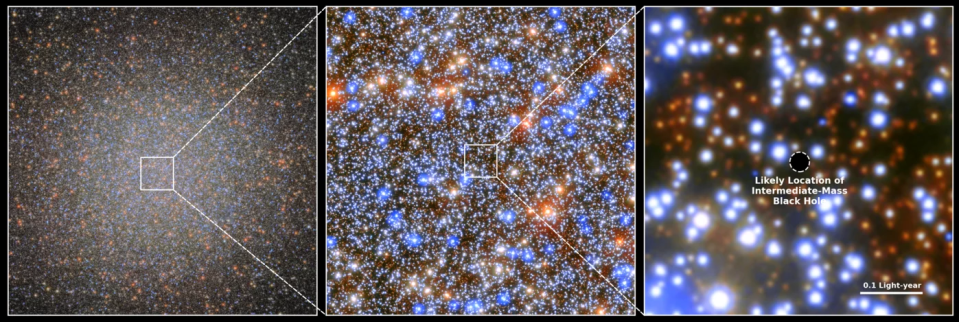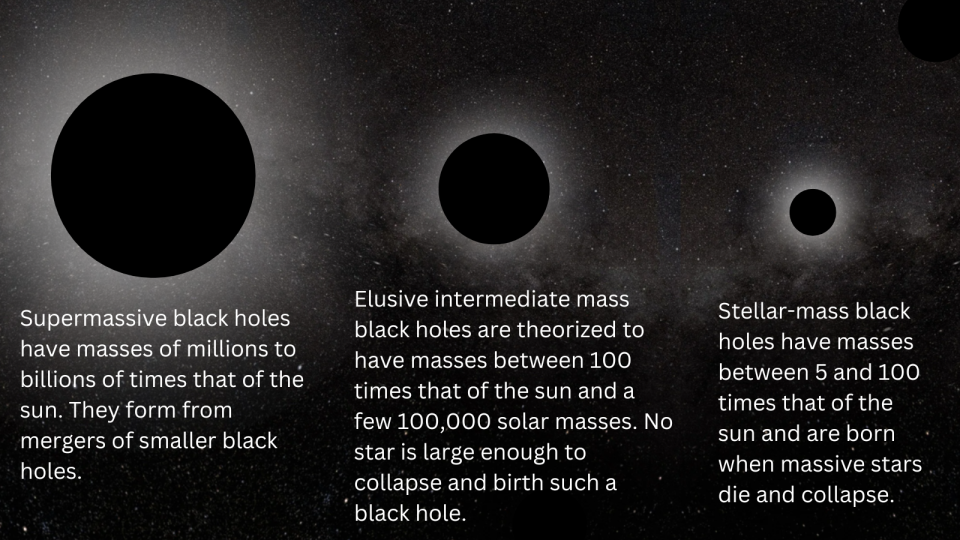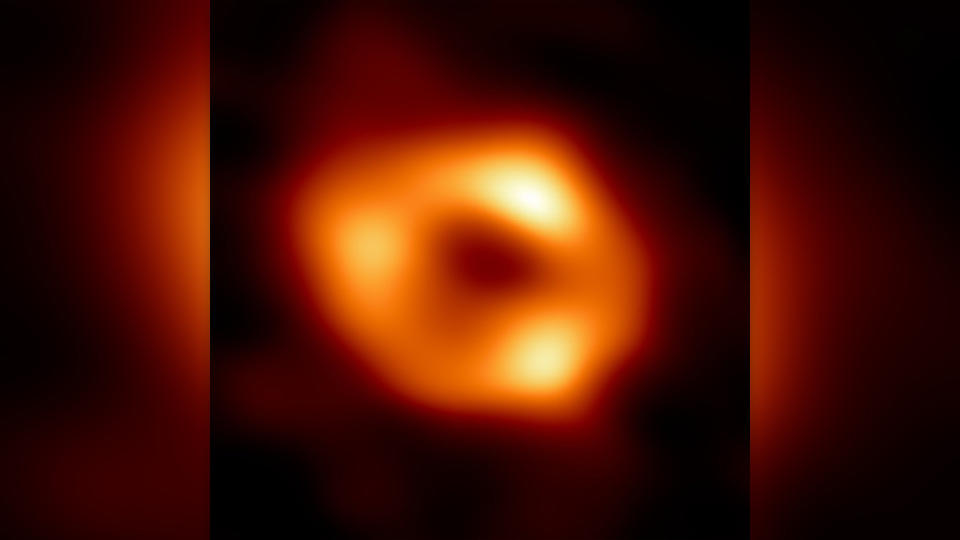Using the Hubble Space Telescope, astronomers have discovered the closest massive black hole ever discovered: a cosmic giant “frozen in time.”
As an example of an elusive “intermediate-mass black hole,” the object could serve as a missing link in understanding the connection between stellar-mass and supermassive black holes. The black hole appears to have a mass of about 8,200 suns, making it significantly more massive than stellar-mass black holes, which have masses between 5 and 100 times that of the sun, and much less massive than the aptly named supermassive black holes, which have masses millions to billions of times that of the sun. The closest stellar-mass black hole scientists have found is called Gaia-BH1, and it lies just 1,560 light-years away.
The newly discovered intermediate-mass black hole is located in a spectacular collection of about ten million stars called Omega Centauri, which is about 18,000 light-years away from Earth.

Interestingly, the fact that the ‘frozen’ black hole appears to have stunted its growth supports the idea that Omega Centauri is the remnants of an ancient galaxy that was devoured by our own.
Related: See how a supermassive black hole holds on to a ‘fluffy’ disk in this simulation
This would suggest that Omega Centauri is in fact the core of a small, separate galaxy whose evolution was aborted when the Milky Way swallowed it. If this event had never happened, this intermediate black hole might have grown to supermassive status, much like the Milky Way’s own supermassive black hole, Sagittarius A* (Sgr A*), which has a mass 4.3 million times that of the Sun and is located 27,000 light-years from Earth.
In search of what is missing
Scientists have known for some time that not all black holes are created equally. While stellar-mass black holes are known to be created by the collapse of stars with at least eight times the mass of the sun, supermassive black holes must have a different origin. That’s because no star is so massive that it can collapse and leave behind a remnant millions times as heavy as the sun.
Therefore, scientists propose that supermassive black holes are born and grow by merger chains of larger and larger black holes. This has been proven by the detection of ripples in spacetime, called gravitational waves, that result from black hole mergers.
This process of black hole merger and growth, combined with the huge difference in mass between stellar-mass black holes and supermassive black holes, means that there should be a population of intermediate-mass black holes.


Yet these mid-sized black holes, with masses between a few hundred and a few thousand times that of the sun, appear to have largely evaded detection. That’s because, like all black holes, these mid-sized cosmic titans are marked by outer boundaries called event horizons.
The event horizon is the point at which the gravitational influence of a black hole becomes so immense that even light is not fast enough to escape it. Black holes are thus only visible in light if they are either surrounded by matter to feed on, which glows as it heats up, or are being ripped apart and feeding on an unlucky star in a so-called “Tidal Disruption Event” (TDE).
Intermediate-mass black holes, such as those in Omega Centauri, are not surrounded by much matter and food.
That means astronomers have to be a little sneaky when hunting for such black holes. They use the gravitational effects that these holes have on matter, such as stars orbiting them or light passing through them. The team behind this new discovery used the first method.
A fast star
The search for this medium-sized black hole began in 2019, when Nadine Neumayer of the Max Planck Institute for Astronomy (MPIA) and Anil Seth of the University of Utah designed a research project to improve our understanding of the formation history of Omega Centauri.
In particular, the researchers, and collaborator Maximilian Häberle, an MPIA Ph.D. student, wanted to find fast-moving stars in Omega Centauri that would provide evidence that the cluster has a massive, dense, or compact, “central engine” black hole. A similar method was used to determine the mass and size of Sgr A* using a fast-moving population of stars at the heart of the Milky Way.
Häberle and his team used more than 500 Hubble images of this star cluster to build a massive database of the motions of stars in Omega Centauri, measuring the velocities of about 1.4 million stars. This repeated view of Omega Centauri, which Hubble performed not for scientific interest but rather to calibrate its instruments, was the ideal dataset for the team’s mission.
“Looking for superfast stars and documenting their motion was like looking for a needle in a haystack,” Häberle said. The team ended up finding not one, but seven “needle-in-a-haystack stars”, all moving at high speed in a small region at the heart of Omega Centauri.


The high speed of these stars is caused by a concentrated mass nearby. If the team had found just one fast star, it would have been impossible to tell whether the speed was the result of a large, dense central mass or whether that star is a runaway, moving quickly in a straight line — with no central mass at all.
By spotting and measuring the different velocities and directions of seven stars, this determination was made. The measurements revealed a centralized mass equal to 8,200 suns, while visual inspections of the area revealed no objects that looked like stars. That’s exactly what you’d expect if a black hole were found in this region, which the team determined was “light months” wide.
The fact that our galaxy is mature enough to have a supermassive black hole at its heart means that it has probably outgrown the stage where it has many medium-mass black holes of its own. This one is in the Milky Way, the team says, because the cannibalization of its parent galaxy has coincidentally curtailed its growth processes.
RELATED STORIES:
— For the first time, dark matter has been discovered dangling from the cosmic web
— Exotic ‘Einstein ring’ suggests mysterious dark matter interacts with itself
— Tiny black holes left over from the Big Bang may be prime suspects for dark matter
“Previous studies had raised critical questions like, ‘So where are the superfast stars?’ We now have an answer to that question and confirmation that Omega Centauri contains an intermediate-mass black hole,” Häberle said. “At a distance of about 18,000 light-years, this is the closest known example of a massive black hole.”
Of course, this doesn’t change Sgr A*’s status as the closest supermassive black hole to Earth, or Gaia BH1’s status as the closest black hole with the same mass as Earth. But it does provide some reassurance that scientists are on the right track when it comes to figuring out how our central black hole became such a cosmic behemoth in the first place.
The team’s research was published Wednesday (July 10) in the journal Nature.